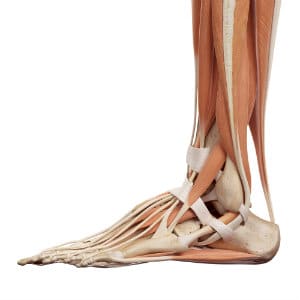Get the Scoop on Peroneal Tendon Injuries
Have you ever noticed when walking along the ocean on a sloping beach that the outside of your ankle starts to hurt? The joint may sometimes even give way briefly, causing a quick pain. One reason could be a peroneal tendon injury. The problem is not that common, but it can also happen from overuse in sports that require a lot of ankle motion—like volleyball, basketball, and running.

Why Tendon Problems Develop
Two peroneal tendons in each leg connect your calf muscles to the side and arch of your foot. As they make the turn at your ankle, they run behind the protruding ankle bone (which is actually the enlarged end of your fibula) and are held in place by a sheath of tissue called the retinaculum. Every time your foot moves up and down, they slide along in this “channel.” Constant irritation from the friction, suddenly increasing an activity like running, wearing shoes that don’t support your foot properly, or getting another injury like an ankle sprain are all possible causes of tendon problems.Types of Peroneal Tendon Injuries
The problem can take four different forms:
- Tendonitis – the tissue becomes inflamed, either from friction against the bone or some other trauma such as an ankle sprain, resulting in pain, swelling and warmth around the outer ankle bone.
- Tendonosis – overuse can gradually stretch out and thin the tissue bands over time so that the fibers begin to break down, fray, or split. This can lead to intermittent pain and a feeling that the ankle wants to give way.
- Acute tear – often due to a traumatic impact, but sometimes also to accumulated stress, the fibers actually break, sometimes rupturing it completely in two. The area will swell and hurt, and you also may not be able to do your normal activities because the foot feels weak or unstable.
- Subluxation – You may actually be able to hear this happen. The connectors can “snap” over the bone as you walk or rotate your ankle and they slip out of position. This can be quite painful when it happens, but the discomfort usually comes and goes. It can also result in a weak and unstable ankle.
How to Determine What’s Wrong
You may not recognize what is happening, because the problem isn’t as common as a sprain or pulled muscle. That’s why it is best to have any unexplained pain on the outside of your ankle investigated by our specialists to determine exactly what’s going on. This will mean a physical evaluation of the foot, and may also include x-rays or other imaging tests. We will check for related injuries like sprains or fractures at the same time.Ways to Treat Peroneal Tendon Injuries
The tissue needs to heal—whether it is simply inflamed, or if degeneration or tearing has occurred. That means it needs to stay still and relaxed, which sometimes means wearing a cast or splint for a while to keep the ankle from moving. Medications we prescribe may help with acute pain, and using ice packs, heat, or ultrasound can numb the discomfort and reduce swelling. In some cases, you may need to wear a foot and ankle brace for a while when doing activities, to keep from re-injuring the tendons. Less often, surgery may be needed to fix the ends of the connector together or reduce irritation from surrounding tissues.Let Our SoCal Experts Treat Your Foot Pain
When you experience outer ankle pain, don’t wait and let it get worse. Be proactive and quickly set up an appointment with our staff to have the problem evaluated and treated. You can reach the office of Southern California Foot & Ankle Specialists in Ladera Ranch, CA by dialing (949) 364-9255 (WALK), or you can request your appointment right now by filling out our online form.Contact Us
Ladera Ranch
333 Corporate Dr. Ste 230, Ladera Ranch, CA 92694
Tel: (949) 364-9255 (WALK)
Fax: (949) 364-9250
Office Hours:
Monday - Friday: 9am - 5pm
*(Lunch 12 noon - 1pm)
Orange
2617 E Chapman Ave. Ste 303, Orange, CA 92869
Tel: (714) 639-7993
Fax: (714) 639-0729
Office Hours:
Monday - Friday: 9am - 5pm
*(Lunch 12 noon - 1pm)
